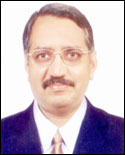 Dr. Katta Venkataramana, Professor and Head, Department of Civil Engineering, National Institute of Technology Karnataka, Surathkal, is of the opinion that India’s long coastline can be tapped to harness wave and wind energy to meet the country’s growing demand for electricity. “India has one of the longest coastlines and its full potential is yet to be utilised. The energy needs of India can be met to a great extent by harnessing the wave energy and wind energy using suitable installations located along the coastline and also at many offshore locations,” said Dr. Venkataramana, whose current research interests include structural dynamics, earthquake engineering and offshore structural engineering.
Dr. Katta Venkataramana, Professor and Head, Department of Civil Engineering, National Institute of Technology Karnataka, Surathkal, is of the opinion that India’s long coastline can be tapped to harness wave and wind energy to meet the country’s growing demand for electricity. “India has one of the longest coastlines and its full potential is yet to be utilised. The energy needs of India can be met to a great extent by harnessing the wave energy and wind energy using suitable installations located along the coastline and also at many offshore locations,” said Dr. Venkataramana, whose current research interests include structural dynamics, earthquake engineering and offshore structural engineering.
Moored offshore platforms such as spars, tension-leg-platforms and semi-submersibles that have been used in exploration and exploitation of oil and gas could be used to harness renewable energy by installing wind turbines. Advancements in this field were underway around the world. These include London Array which is regarded as the world’s largest offshore wind farm, he said.
“India, too, is looking forward in this direction, especially due to the acute power shortfall and the resistance offered to its nuclear installation plans after the nuclear disaster in Japan,” Dr. Venkataramana said. The proposed offshore wind farm in Dhanushkodi, Tamil Nadu, seemed to be driven by water depth rather than the peak power generation, he noted.
He continued, “There is a tremendous scope for development of offshore structures for oil and gas exploration in deep sea (i.e. conventional energy resources) as well as for harnessing renewable energy such as wave and wind energy by installations in offshore and near-shore regions.
Dr. Venkataramana obtained his B.E. (Civil Engineering) from University of Mysore in 1981. In Japan, he did his M.E. (Ocean Civil Engineering) from Kagoshima University, in 1986, and doctoral degree from Kyoto University, in 1989. He worked as research engineer at Sumitomo Metal Industries, Japan, during 1989-90, as post-doctoral Research Fellow at University of Oxford, UK, during 1990-91, and later as Assistant Professor (1991-94) and Associate Professor (1995-2002) at Kagoshima University, Japan.
After living abroad for two decades, mainly in Japan and UK, Dr. Venkataramana returned to India in 2002 and became Professor of Structural Engineering in the Department of Civil Engineering, NITK, Surathkal, which is one of India’s premier technical institutes. He currently heads the department.
Discussing coastal development, Dr. Venkataramana said there was a need for regulated development along the coastal region to achieve the necessary infrastructure that would on one hand meet the energy requirement and on the other preserve the coastline for future generations.
“The offshore structural engineering field offers tremendous opportunities for exponential growth. At the same time challenges must be overcome to achieve sustainability and preservation of environment,” he said. “It is important that engineers, industries, academicians and policymakers join hands and work together towards achieving sustainable growth of offshore industry in harmony with the environment.”
Dr. Venkataramana has coauthored three books and has published more than 200 technical papers in journals and conference proceedings. He is a fellow of Institution of Engineers (India) and life member of many professional societies. He is also chairperson of the technical committee constituted by the district administration for revising the building byelaws and zoning regulations of Mangalore city in Karnataka.
In recognition of his achievements in, and contribution, to civil engineering, the Association of Consulting Civil Engineers (India), Mangalore Centre, conferred him with the ‘Eminent Engineers’ Award 2013’ during Engineers’ Day celebrations held on September 15, 2013.











